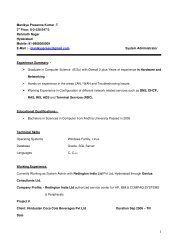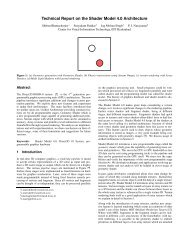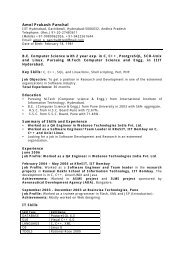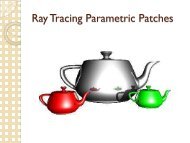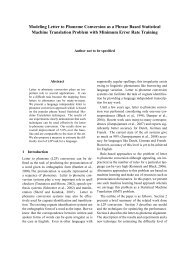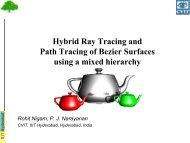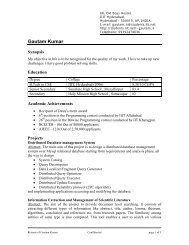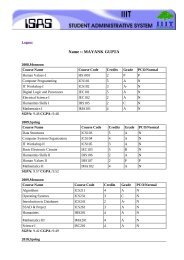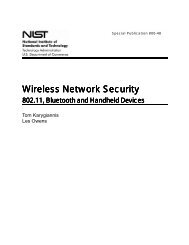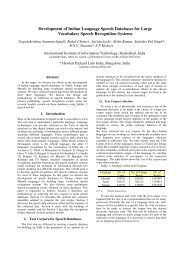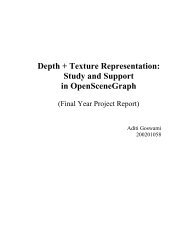Hybrid ray tracing and path tracing of bezier ... - IIIT Hyderabad
Hybrid ray tracing and path tracing of bezier ... - IIIT Hyderabad
Hybrid ray tracing and path tracing of bezier ... - IIIT Hyderabad
You also want an ePaper? Increase the reach of your titles
YUMPU automatically turns print PDFs into web optimized ePapers that Google loves.
<strong>IIIT</strong> <strong>Hyderabad</strong><br />
HYBRID RAY TRACING AND<br />
PATH TRACING OF BEZIER SURFACES<br />
USING A MIXED HIERARCHY<br />
Rohit Nigam, P. J. Na<strong>ray</strong>anan<br />
CVIT, <strong>IIIT</strong> <strong>Hyderabad</strong>, <strong>Hyderabad</strong>, India
<strong>IIIT</strong> <strong>Hyderabad</strong><br />
Bezier Surfaces<br />
• Bezier Surfaces are the most basic form <strong>of</strong> parametric<br />
surfaces<br />
• A Bezier Surface can be described as:<br />
Q(u,v) = [U][M][P][M] T [V] T<br />
where [U] = [u 3 u 2 u 1] <strong>and</strong> [V] = [v 3 v 2 v 1], 0 ≤ u,v ≤ 1<br />
[M] is the Bezier Basis Matrix<br />
[P] is the set <strong>of</strong> 16 Control Points defining the patch
<strong>IIIT</strong> <strong>Hyderabad</strong><br />
Bezier Surface : Motivation<br />
• Advantages<br />
‣ Provide compact <strong>and</strong> effective representation.<br />
‣ Remain curved <strong>and</strong> smooth at arbitrary level <strong>of</strong> zooming.<br />
‣ Memory efficient, in comparison with triangular mesh.<br />
• Rendering <strong>of</strong> Parametric Surfaces<br />
– Eisenacher et al.(2009) : View Dependent Adaptive Subdivision<br />
– Geimer et al.(2005) : Newton Iteration<br />
– Pabst et al.(2006) : Bezier Clipping + Newton Iteration
<strong>IIIT</strong> <strong>Hyderabad</strong><br />
Previous work on Ray Tracing<br />
<strong>of</strong> Bezier Surfaces<br />
1<br />
2 3<br />
BVH Nodes<br />
P1 P2 P3 P4 P5 P6 Subpatches at<br />
Leaf<br />
• Based on the flatness criteria, each patch is divided into<br />
subpatches.<br />
• BVH for given surfaces<br />
– Bounding boxes <strong>of</strong> subpatches at leaf nodes.<br />
• For each <strong>ray</strong> intersecting a subpatch<br />
– Generate initial values for Newton Iteration
<strong>IIIT</strong> <strong>Hyderabad</strong><br />
Limitation <strong>of</strong> the Model for GPUs<br />
• GPU Access time:<br />
– High for global memory<br />
– Comparatively less for shared memory <strong>and</strong> registers<br />
When subdividing based on flatness criteria, we need to<br />
– Store subpatches starting index<br />
– Store total number <strong>of</strong> subpatches<br />
– Store initial [u,v] pair for each potential intersection.<br />
Thus more global memory operations result in lower<br />
throughput.<br />
• Need to check every subpatch at leaf node
<strong>IIIT</strong> <strong>Hyderabad</strong><br />
Our Approach<br />
• Create a mixed hierarchy, consisting <strong>of</strong> two hierarchical<br />
structures.<br />
– Each Patch is divided into fixed size subpatches, hierarchically,<br />
using De Casteljau algorithm.<br />
– The top level BVH tree is constructed from the original patches.<br />
– Leaf nodes represent the original Bezier Surfaces.<br />
– Make subtree for each patch from the subdivided patches.
<strong>IIIT</strong> <strong>Hyderabad</strong><br />
BVH for<br />
Patches<br />
BVH Nodes<br />
Patches<br />
1 2 3 4<br />
Subtree Nodes<br />
Subpatch<br />
Hierarchy<br />
Sub-patches
<strong>IIIT</strong> <strong>Hyderabad</strong><br />
Mixed Hierarchy Structure<br />
• Create the first level BVH using the Bounding Boxes <strong>of</strong><br />
the original surface patches.<br />
• Create 2 nd level BVH by alternately subdividing along u<br />
<strong>and</strong> v parameters.<br />
– A subdivision depth <strong>of</strong> 6 was found empirically sufficient for our<br />
scenes.<br />
– Fixed depth makes it possible to store skip pointers, used for<br />
traversing the subtree <strong>and</strong> subpatch numbers to get initial<br />
values.<br />
– A subtree at lower level leads to early termination at this stage,<br />
reducing the (Ray, Bounding Box) intersections.<br />
– Subdivision also leads to tighter bounds, which further reduces<br />
the potential (Ray,Patch) intersections.
<strong>IIIT</strong> <strong>Hyderabad</strong><br />
GPU Traversal <strong>of</strong><br />
Mixed Hierarchy Structure<br />
• A ‘traverse’ kernel traverses the first level <strong>of</strong> the BVH.<br />
– Lists out Potential (Ray,Patch) intersections.<br />
– We make use <strong>of</strong> atomic operations, to provide scalability.<br />
• ‘Recheck’ kernel parallely processes the generated<br />
(<strong>ray</strong>,patch) list.<br />
– This leads to further pruning <strong>of</strong> the list with tighter subpatch<br />
bounding boxes.<br />
– We make use <strong>of</strong> ‘t’ values computed here, to not traverse<br />
subpatch nodes with higher values.<br />
– This leads to reduced computation <strong>and</strong> in cases <strong>of</strong> false<br />
positive, a little less accurate initial values.<br />
– Lists out the reduced potential (Ray,Patch) intersections.<br />
– Generates the initial values for each intersection.
<strong>IIIT</strong> <strong>Hyderabad</strong><br />
Newton Iteration<br />
• We represent a <strong>ray</strong> as intersection <strong>of</strong> two planes, (n 1 ,d 1 )<br />
<strong>and</strong> (n 2 ,d 2 )<br />
The <strong>ray</strong> patch intersection equation becomes<br />
Q(u,v) represents the point on the patch.<br />
• We use Newton Iteration to solve for (u,v)<br />
Here J is the inverse Jacobian matrix <strong>of</strong> R.
<strong>IIIT</strong> <strong>Hyderabad</strong><br />
<strong>Hybrid</strong> Ray Tracing<br />
Divide the Ray list between CPU <strong>and</strong> GPU<br />
GPU algorithm comprises<br />
<strong>of</strong> three kernels:<br />
Traverse : Generate<br />
Potential Ray-Patch<br />
Intersections<br />
Recheck : Further prune<br />
intersections <strong>and</strong> get initial<br />
values<br />
Newton : Apply Newton<br />
iteration to get hit-point<br />
CPU stage comprises <strong>of</strong>:<br />
1. Divide CPU Raylist into<br />
2c threads, where c is<br />
number <strong>of</strong> cores.<br />
2. Intersect with main BVH<br />
3. If intersects, intersect<br />
with 2 nd level subtree.<br />
4. Apply Newton iteration<br />
to get hit-point
<strong>IIIT</strong> <strong>Hyderabad</strong><br />
<strong>Hybrid</strong> Ray Tracing
<strong>IIIT</strong> <strong>Hyderabad</strong><br />
Path Tracing<br />
• We extend our <strong>ray</strong> <strong>tracing</strong> approach to Global<br />
Illumination effects.<br />
• We use Cook’s approach <strong>of</strong> Monte Carlo based<br />
Stochastic Sampling, to sample the image at<br />
appropriate non-uniformly spaced points.<br />
• Each pixel is sampled for a user defined samples per<br />
pixel<br />
• We apply our data parallel approach to this massive <strong>ray</strong><br />
list to generate the desired effects.
<strong>IIIT</strong> <strong>Hyderabad</strong><br />
Path Tracing<br />
Bigguy in a box: 10000 spp, 512x512 resolution<br />
Rendered in 28.5 minutes
<strong>IIIT</strong> <strong>Hyderabad</strong><br />
Results (Primary Rays, 1024x1024)<br />
Model<br />
Patche<br />
s<br />
Ray-Patch<br />
Intersections<br />
Total Frame Time(ms)<br />
CPU GPU <strong>Hybrid</strong><br />
Teapot 32 126589 74 8.71 8.01<br />
Bigguy 3570 142779 110 14.59 13.18<br />
Killeroo 11532 147116 193 22.38 20.43<br />
2 Killeroos 23064 317494 356 42.29 38.58<br />
9 Bigguys 32130 570136 2092 77.05 75.9
<strong>IIIT</strong> <strong>Hyderabad</strong><br />
Results (Primary +Secondary)<br />
Model<br />
Patche<br />
s<br />
Total Frame Time(ms)<br />
CPU GPU <strong>Hybrid</strong><br />
Teapot 32 137 17.05 15.61<br />
Bigguy 3570 232 39.45 34.92<br />
Killeroo 11532 351 58.3 52.19<br />
2 Killeroos 23064 726 106.03 94.55<br />
9 Bigguys 32130 3107 196.79 191.81
<strong>IIIT</strong> <strong>Hyderabad</strong><br />
Conclusion<br />
• A mixed hierarchy model is proposed to speed up Ray<br />
Tracing process.<br />
• GPU benefits greatly from fixed depth subtree.<br />
• A hybrid model is proposed, to fully utilize compute<br />
power <strong>of</strong> CPU <strong>and</strong> GPU.<br />
• We demonstrate the capability <strong>of</strong> our method by<br />
performing global illumination for Bezier patches.
<strong>IIIT</strong> <strong>Hyderabad</strong><br />
THANK YOU
<strong>IIIT</strong> <strong>Hyderabad</strong>
<strong>IIIT</strong> <strong>Hyderabad</strong><br />
<strong>Hybrid</strong> Ray Tracing<br />
• Divide the Ray list between CPU <strong>and</strong> GPU<br />
‣ Ratio decided based on compute capabilities<br />
• GPU algorithm comprises <strong>of</strong> three kernels:<br />
‣ Traverse : Generate Potential Ray-Patch Intersections<br />
‣ Recheck : Further prune intersections <strong>and</strong> get initial values<br />
‣ Newton : Apply Newton iteration to get hit-point<br />
• CPU stage comprises <strong>of</strong>:<br />
1. Divide CPU Raylist into 2c threads, where c is number <strong>of</strong> cores.<br />
2. Intersection with main BVH<br />
3. If intersects, further intersection with 2 nd level subtree.<br />
4. Finally, apply Newton iteration <strong>and</strong> generate hit-point<br />
• CPU benefits from early <strong>ray</strong> termination.



